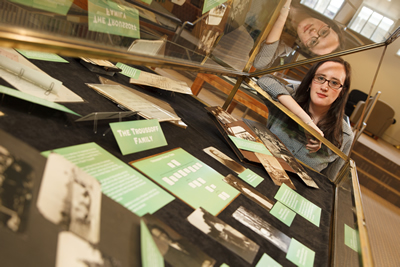From Russia, With Love

Caitlin Moriarty '13 is curator of archives' latest exhibit.
by Sasha Shapiro '15
Standing perched on a grassy knoll, you can almost feel the soothing country breeze as you gaze down at the magical sight before you: a rickety wooden fence borders a dirt road cutting across summits of rolling hills striped with green grass and golden flower fields. A wooden bridge cuts across an indigo creek, leading to a humble village at the base of a magnificent dvaretz-a castle with a traditional Russian onion dome roof poking the opaque, billowing clouds overhead. Emerald pine trees border the horizon-what lies beyond them is unknown.
This is one of the many set-design sketches crafted by Basil Troussoff, a former munitions inspector for the Russian Imperial Army. Nearly 50 years after its creation, Troussoff's granddaughter, Gail Troussoff Marks '73, has donated many of his possessions to Dickinson's Archives & Special Collections in hopes of sharing his vibrant life with future generations. The exhibition, Family Story: The Trousoff Collection, is open through June 30.
Life in a New World
Troussoff's life story is nothing short of fascinating: Stationed in New York City in 1914 on military business, Troussoff had every intention of returning home to Moscow. His travel plans, however, came at a tumultuous time: Many of Troussoff's belongings already had been shipped back to Russia when Bolshevik Communists took power, and the possibility of returning to his old life was impossible. Troussoff was forced to abandon hope of returning to Russia and instead began a new life in New York City.
Troussoff's engineering training and work had not kept him from nourishing a life-long passion for artistic expression. He studied painting and set design during his years at the engineering institute in St. Petersburg and collected Russian folk paintings, postcards and storybooks. In St. Petersburg and later in Moscow, Troussoff became acquainted with the Russian artists of the World of Art movement, and at the time Troussoff accepted the munitions-inspector job that brought him to New York, he was working in the studio of Konstantin Yuon, World of Art artist.
Gathering History
In 1919-20, Troussoff was hired as a set designer by artist Joseph Urban and was able to continue cultivating his artistic skills. Troussoff also kept many of his letters with his sister, Elena, who chose to remain in Russia.
It's incredible to imagine the confusion that must have prevailed in Russia in the early 1920s. The Communist takeover of Russia itself was immediate—the entire switch of power itself lasted about four minutes. Troussoff's collection offers a rare insight into this period of Russian history, and his unique position in this political and social revolution is highlighted in his letter exchanges and art collection. Troussoff Marks admits that her grandfather never truly let go of his Russian culture, even during his later years. "My grandfather was a special person," Troussoff Marks says. "Sifting through his collection has given me a fuller sense of who he was and how he lived his life."
Organizing a Fascinating Life
In the process of organizing her grandfather's personal collection, Troussoff Marks collaborated extensively with Russian major Caitlin Moriarty '13, a student archivist assistant. Moriarty, as managing student curator of the collection, has spent the last year archiving and assembling the exhibition. "I love how narrative this collection is," Moriarty says, referring to Troussoff's letter exchanges with Elena, as well as his visual art collection. "Through their artifacts, you come to know the family really well … it's an amazing example of how history is story telling."
Because they were written with archaic Russian letters that Soviet linguists later eradicated from the alphabet, many of Basil's and Elena's letters were difficult to decipher. Russian major Megan Browndorf '08 had begun the translation work, and Moriarty picked up where Browndorf left off.
Moriarty notes that her managerial role in the Troussoff exhibit was spontaneous and grew from these collaborations and discussions. "Initially, I was only cataloguing Troussoff's collection for research, but the artistic component made me want to exhibit it," she says. "His collection is like a collage - it's interdisciplinary. It has the potential to interest anyone-especially people who are not Russian majors."
An opening reception will be held on Sunday, April 21.
Published April 11, 2013